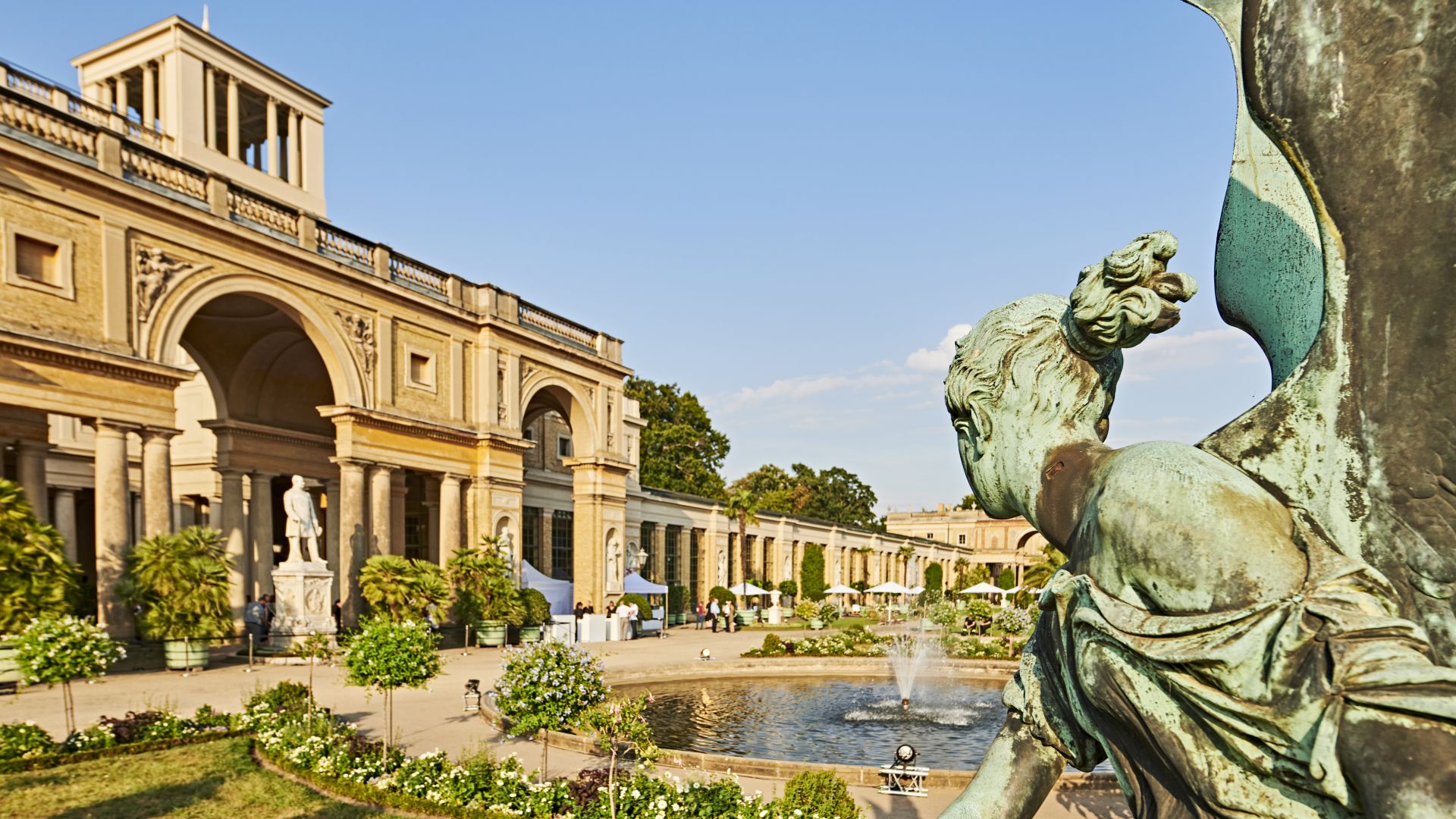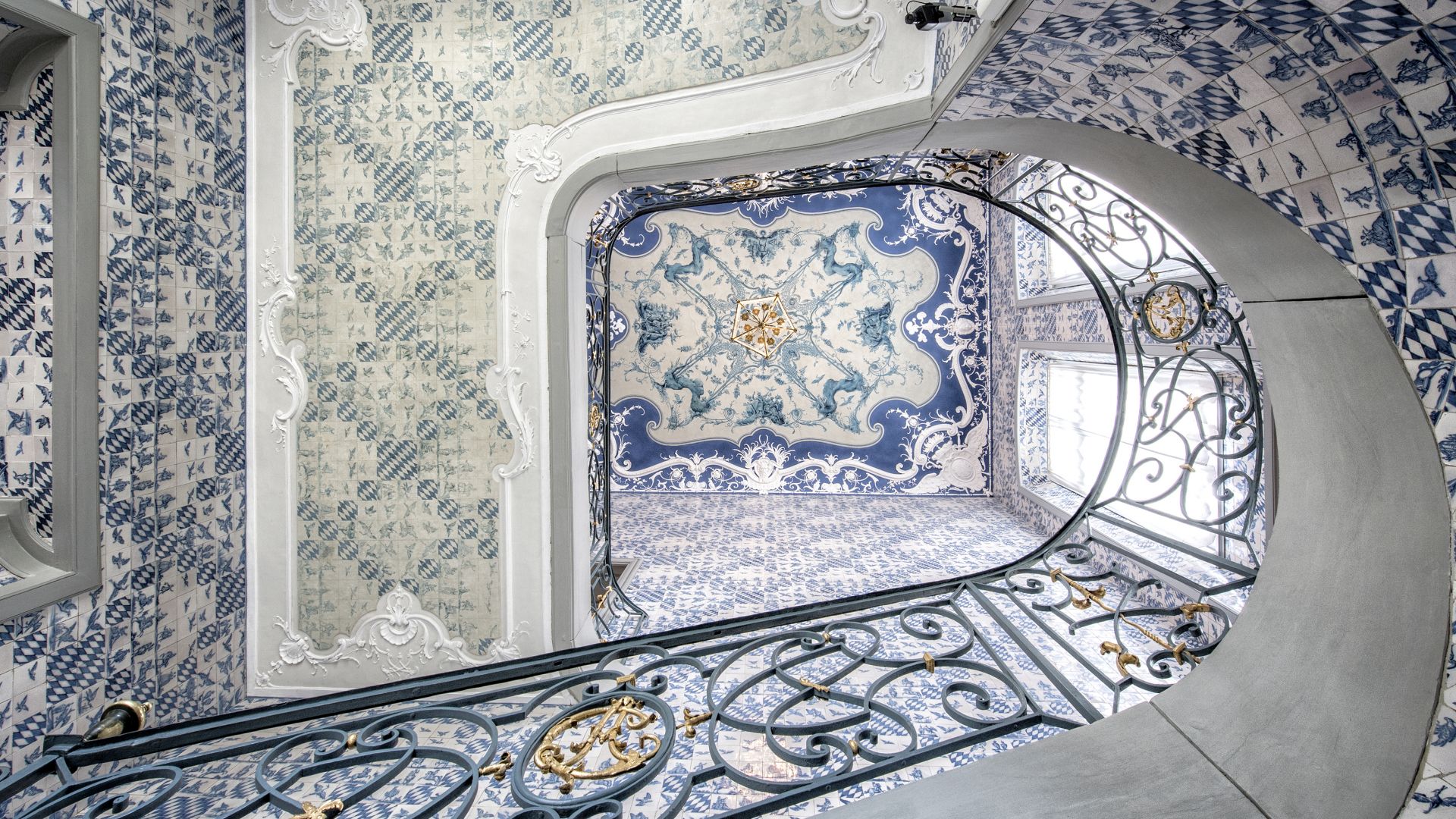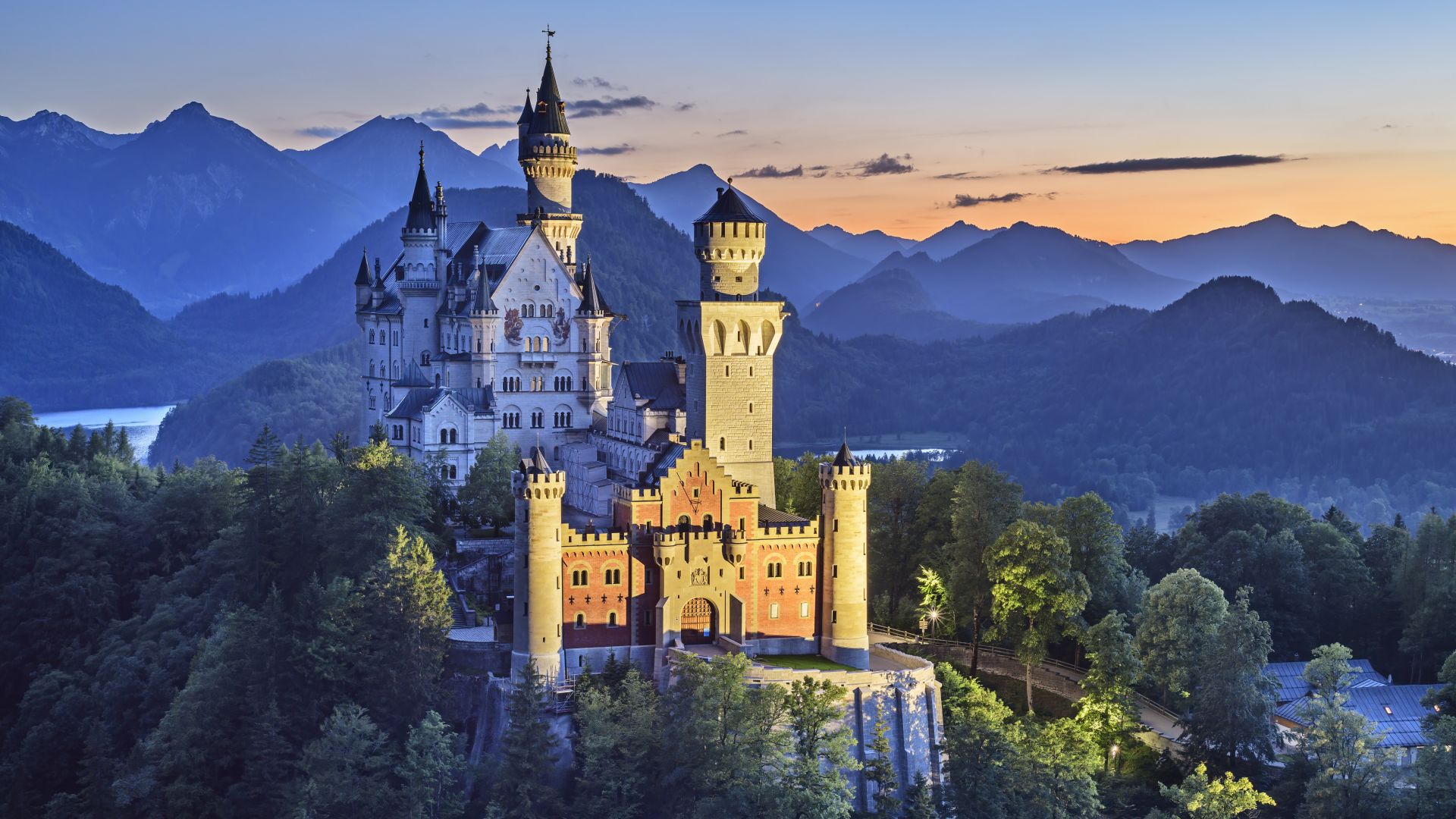Castles & Palaces
16 highlights in Germany
Some 25,000 castles, palaces and mansion houses bear witness to Germany's history: from splendid, perfectly preserved landmarks to ruined reminders of former glory.
Splendid palaces of great rulers
Germany is home to a great variety of castles and palaces, from simple mansion houses to the prestigious residences of great ruling dynasties, such as Sanssouci Palace in Potsdam. Known as the "Prussian Versailles", this castle was constructed on the orders of the Hohenzollern King Friedrich II. Together with its park, this Rococo building has been a UNESCO World Heritage Site since 1990. Another favourite place of the Hohenzollern dynasty was Berlin's Charlottenburg Palace.
Situated close to the Saxon state capital of Dresden, the moated castle of Moritzburg was the emblem of the noble Wettin dynasty. The Baroque estate also includes the Little Pheasant Castle, visible from Moritzburg Castle 2.5 kilometres away.
 Potsdam: Orangerieschloss im Park Sanssouci
©DZT (Jens Wegener)
Potsdam: Orangerieschloss im Park Sanssouci
©DZT (Jens Wegener)
Cultural heritage and architectural jewels
As well as Sanssouci Palace, other German castles and palaces are also UNESCO World Heritage Sites, including Augustusburg and Falkenlust Palaces located in Brühl (North Rhine-Westphalia) and boasting gardens and parks that transport visitors back to the 17th century. One UNESCO Site in Hesse is Wilhelmshöhe Park, a landscape park above Kassel with the Classicist Wilhelmshöhe Palace at its centre. Wartburg Castle occupies an elevated position above the Thuringian city of Eisenach. This World Heritage Site is renowned as the place where the reformer Martin Luther sought refuge and translated the New Testament into German.
Some castles and palaces are perfect examples of their respective architectural eras. Ahrensburg Palace near Hamburg, for example, is regarded as one of the major works of Renaissance architecture in Schleswig-Holstein. Occupying a central location in the city, Saarbrücken Castle is a fine example of Baroque style, while the far smaller Schönebeck Castle in Bremen-Vegesack combines Baroque with a typical north-German half-timber construction. Jenisch House in Hamburg is a Classicist gem. Set in extensive landscaped gardens, this country house enjoys far-reaching views over the River Elbe.
 Palace Brühl
©DZT (Florian Trykowski)
Palace Brühl
©DZT (Florian Trykowski)
Fairytale palaces and knights' castles
The Romantic era was the real heyday for castles, with the most emblematic example being Neuschwanstein Castle. This splendid white construction is perched on a hilltop near Füssen in the Bavarian Allgäu. Somewhat less well known is the "Neuschwanstein of the North": Schwerin Castle was once a residence for grand dukes and is now the seat of the state parliament of Mecklenburg-Western Pomerania. Romantic Historicism was also the inspiration for the construction of Marienburg Castle. The Guelph family's Neo-Gothic-style summer residence is a striking landmark, perched high on Marienberg hill around 20 kilometres south of Hanover in Lower Saxony. Further to numerous conversions over the years, Wernigerode Castle in Saxony-Anhalt is now another fairytale castle.
But what later constructions strived to replicate can be still be admired in their original form today: storybook-style Medieval castles. The most famous example being perhaps Eltz Castle. This 12th century hilltop castle in the Eifel mountains in Rhineland-Palatinate has been owned by the same noble family for over 850 years. And for many generations, the romantic appeal of ancient ruins has been attracting international tourists to Heidelberg Castle in the town by the Neckar in the north of Baden-Württemberg.
 Schwangau: Neuschwanstein Castle illuminated at dusk in front of the Tannheimer Mountains, Ammergau Alps
©lookphotos (Andreas Strauß)
Schwangau: Neuschwanstein Castle illuminated at dusk in front of the Tannheimer Mountains, Ammergau Alps
©lookphotos (Andreas Strauß)
Castles and Palaces – A Surprising Journey of Discovery
Close your eyes and let yourself be acoustically enchanted by the diverse impressions on your journey through Germany!
Intro with music:
“Experience Germany – A Surprising Journey of Discovery”
High walls and pointed towers, picturesquely situated on a hilltop: the Neuschwanstein Castle in Bavaria’s Allgäu region is one of Germany’s most famous sights. The museum advisor of the castles of Ludwig the Second, Dr. Uwe-Gerd Schatz, says this is because it has a unique selling point that is unlike most other castles.
OST Schatz: Neuschwanstein, Bavaria
Man: The Neuschwanstein Castle is white. This was a change of plan by Louis the Second that happened during the construction. He wanted cladding with white limestone. This distant effect in white makes it look unique, also more historical, because white castles like this are only found in paintings in books.
Perhaps that’s why Walt Disney chose it as the model for the castle in Sleeping Beauty. If he had been looking for a medieval knight’s castle, he might have come across Eltz Castle in the Eifel region, which, at any rate, had made it onto the former 500 Deutsche Mark bill. And rightly so, according to the lord of the castle, Jakob zu Elz.
OST Eltz Castle: Skyscraper of the Middle Ages, Rhineland-Palatinate
Man: Eltz Castle is an almost 900-year-old castle, built over 500 years, nestled in a natural paradise and standing completely alone on a rock in a valley. At its highest, it is over 40 meters tall, with up to 10 floors – an actual skyscraper of the Middle Ages.
Charlottenburg Palace in Berlin is quite different, explains Christian Tänzler of Visit Berlin. It served as the summer residence of Prussian kings from 1701 to 1888 and is an important cultural treasure not only because of its unique porcelain exhibition.
OST Charlottenburg Palace
Man: Charlottenburg Palace is found within in a huge park. This beautiful building can be compared to Sanssouci. It has the ambience of a park and is also more or less by the water, so you have the combination of nature and culture. Charlottenburg Palace is perhaps even an unexpected highlight in our cultural scene.
Schwerin Castle is not located by the water, but on it. Katrin Hackbarth of the local tourism association explains that of all the 2,000 castles, manor houses and stately homes in Mecklenburg-West Pomerania, it is the most striking castle.
OST Hackbarth: Schwerin Castle, Mecklenburg-West Pomerania
Woman: It is a fairy-tale castle with many turrets – 365, one for each day of the year, each with a golden dome. A castle that stands in the middle of Lake Schwerin on stilts on a small peninsula. Very imposing, this is all guests’ first port of call in Schwerin: a visit to the castle and a stroll through the gardens. This is the distinctive feature of Mecklenburg-West Pomerania.
It’s a similar story when you visit Heidelberg on the Neckar River, where the imposing ruins of Heidelberg Castle rise high above. It’s worth a visit just for the view from up here, says tour guide Susanne Späinghaus.
OST Susanne Späinghaus, tour guide, Heidelberg Castle, Baden-Württemberg
Woman: This view is incredible. The narrow valley that then opens into the Rhine plain, where everything is so green, then there are the red roofs of the small old town below and the bridge that has crossed the Neckar for centuries. You automatically take a deep breath here. I notice how visitors always go “ah, ah” (for the voice-over: take a deep breath) … and then the cameras come out once they recover from the view. The view is also something very special.
Lively costume tours through the Middle Ages, Renaissance, baroque and Romantic eras bring to life the personal fates of the various castles’ residents. In the Marienburg Castle near Hanover, tour guide Tamara Podesky leads visitors through the royal living quarters.
OST Marienburg Castle: Lady’s maid and film set
Woman: Guests visiting Marienburg Castle would do best to book a scenic tour with, for example, a lady’s maid of the queen, who also appears in traditional robes and tells all of the royal secrets. Various fairy tales have been filmed there, including “All-Kinds-of-Fur” and “The Twelve Months”, which is about dark forces. Our Marienburg Castle is the Neuschwanstein of the north.
Maike Bialek from the Bremen Economic Development Agency admits that this is because fairytale castles are actually rather rare in northern Germany.
OST Schönebeck Palace, Bremen
Woman: We northern Germans have less finely chiseled towers. We are a bit more conservative. We have a moated castle built in the North German half-timbered style in Bremen’s district of Vegesack, located on the Schönebecker Aue, where a small river has been dammed and flows into a small pond in front of the palace: a simple palace, but it has a beautiful half-timbered structure on the outside.
Andreas Lehmberg from the Harzer Tourismusverband reveals that half-timbering can also be found at the very top of Falkenstein Castle in Unterharz, a high medieval hilltop castle that has made headlines as a hidden treasure.
OST Falkenstein Castle: Treasure
Man: The highlight of this treasure is the very valuable, so-called Asseburg cup. It was buried on the castle grounds, and in GDR times the Stasi tried to find it after hearing rumors about the treasure. But it was only after the fall of the Berlin Wall that a son-in-law of Count Lothar von Asseburg, who last lived there, found a treasure map in the will, which made it possible to find the treasure.
Treasures, knights, adventure – many German castles and palaces hold exciting secrets. Birgit Grauvogel from the Tourismus Zentrale Saarland explains that the Saarbrücken Castle has an unusual central glass structure, but the real mystery lies beneath it.
OST Birgit Grauvogel, Saarland
Woman: Beneath the castle, there is a preserved underground fortification with battlements and casemates from the Middle Ages. An insider tip: Visitors should stop by the castle on Sundays at 11 a.m., because that’s when the castle ghost haunts the castle, and where you can access the underground casemates.
From the old town of Saarbrücken, you have a particularly beautiful view of the castle and the baroque garden. Herbert Lang from Hessen Tourismus reports that a park with unique garden art awaits visitors around Hesse’s Wilhelmshöhe Castle in Europe’s largest hillside park, which has impressive water features.
OST Lang: Bergpark Wilhelmshöhe, Hessen
Man: At a certain point, water runs down various cascades into a park, fills the lake, and finally, the fountain starts shooting water. It’s like a really great fireworks display, a grand show, a really sophisticated production from the past. And my own personal highlight is the dachshund games in the Bergpark Wilhelmshöhe. It is really sweet. Anyone can come with their dachshund and then it is day of the dachshunds in the hillside park.
Why not? After all, dachshunds were to German Kaiser Wilhelm the Second what corgis are to Queen Elizabeth.
OUTRO